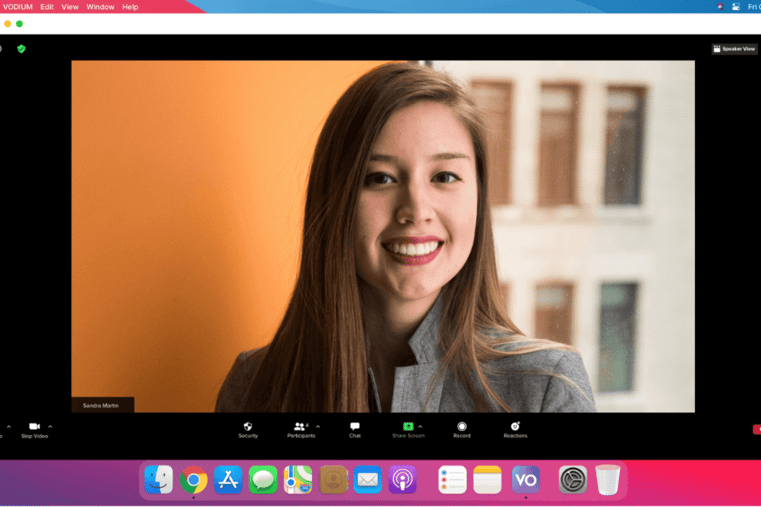How to Engage with Your Audience During a Virtual Presentation
In a world where everyone is inundated with virtual meetings, it’s easy to check out. In fact, an overwhelming majority of 79% of survey respondents find virtual presentations downright dull. That puts a lot of emphasis on the presenter to engage virtual audiences. But don’t worry. If you are not a naturally charismatic speaker with an agenda full of keynote requests, there are some things you can do to engage your audience.

How to Engage Your Audience by Maintaining Eye Contact
Humans are social creatures. We thrive on making connections with our fellow human beings. The best way to attract and hold other people's attention is to make a connection. This human element comes naturally in a face-to-face presentation. But when you put a computer screen between the presenter and the audience, it becomes much more difficult to engage.
Eye contact is the easiest way to make a connection. Even if it is just the illusion of eye contact, the simple act of seeing eye-to-eye makes an individual feel recognized. It’s true—humans are naturally drawn to eye contact from infancy. Maintaining eye contact with the audience can increase self-awareness which is fundamental to the learning process. It also makes your words more memorable and builds trust, allowing the audience to engage with your presentation.
But while the audience is behind a computer screen, making eye contact is counterintuitive. It feels more natural to look at the faces displayed on your monitor than it does to look at your camera. Unfortunately, that leaves your audience looking at your forehead, or at least a downcast gaze. Eye contact is absolutely vital to engaging your audience in a virtual presentation. Luckily, virtual tools like teleprompter apps can be positioned near the camera placement to keep your eyes where they should be.
Promote Interaction While Presenting to an Audience
Your audience should be a part of your presentation. An intense gaze may not be enough to hold your audience's attention all on its own. Your audience may be inclined to multitask during your presentation by checking emails, sending text messages, or even falling asleep. To keep the attention on the presentation, try to incorporate ways to interact with your audience.
Plan your presentation to include frequent pauses and questions posed to the audience. Most presenters plan a presentation around a hierarchy of information, focusing on the key details and providing context for those details. While accuracy is essential, you should also plan from the audience's perspective. Consider what concepts they will likely have the most questions about and prepare questions for discussion. Don’t stop at one question; engage as many participants as possible by asking for opinions or feedback on responses.
Use interactive polls, humor, storytelling, and strong body language to keep the audience engaged throughout the presentation. Start off on the right foot by polling the audience early and identifying different moods in the room. Cater interactions to engage different moods. If you sense that someone is bored, ask them to share a story about themselves related to the topic. Storytelling requires a deeper level of engagement than regurgitating answers.
How to Engage an Audience During a Presentation with Your Body Language
Body language is another way of talking to an audience. Our posture and facial expressions communicate much about our mood and attitude that lies outside our awareness. But in a virtual presentation, your body language is displayed in high-definition as the main focal point. Something as simple as forgetting to smile can derail the entire presentation.
Begin by taking a step back from your computer. One of the biggest mistakes virtual presenters make is to sit at a desk in front of their camera—sitting limits your ability to move around and provides your audience with a very limited view. Consider taking a few steps back from the computer and presenting while standing to articulate a more natural body language to your audience.
Another helpful reminder that can drastically improve body language is a reminder to smile. Even if you are naturally friendly and bubbly, giving a presentation is slightly different. Almost everyone can afford to smile more. If you use a virtual teleprompter app to keep track of your agenda, consider adding frequent reminders to smile. These apps are usually designed so that the notes are only visible to the presenter.
How to Engage Audience in Presentation with the Right Tone of Voice
The monotone speaker is a stereotype that marks the epitome of dull and boring presentations. How your voice sounds while speaking to an audience plays a significant role in engagement. Appropriate inflection is as important as clear language and a comfortable pace. In short, your audience needs to be able to understand your words.
Fast speakers can lose their audience simply because they cannot keep up with their speaking rate, missing large chunks of information. Similarly, when your tone of voice doesn’t match your words, your engagement will suffer. Important information should be emphasized with louder, slower, more deliberate speech. A well-timed pause to allow the audience to digest the information is also key.
Your vocal skills matter in any presentation but are especially important in virtual presentations. Your confidence and interest in the subject come through in your voice. A tone that fails to use inflection is boring, and a tone that misuses inflection is confusing. As the presenter, you need to be clear and exciting.

Don't forget the power of body language in order to engage your virtual audience.
The Bottom Line: Engage the Audience Actively
Engaging with your audience becomes much more difficult when presenting virtually. The nuances of communication, like body language and eye contact, that are natural in person can become difficult to maintain virtually. Delivering a great presentation in a virtual meeting is not impossible, but it does take some practice. A virtual teleprompter app can help bridge the gap by holding eye contact with your camera through ideal on-screen placement and by offering helpful reminders to smile and engage.
VODIUM is a virtual teleprompter app that can help presenters deliver high-impact virtual presentations. The app sits on top of your other programs for easy access and displays your speech, notes, or agenda with optimal placement to keep your eyes looking directly at your camera. Learn more today!


COMMENTS